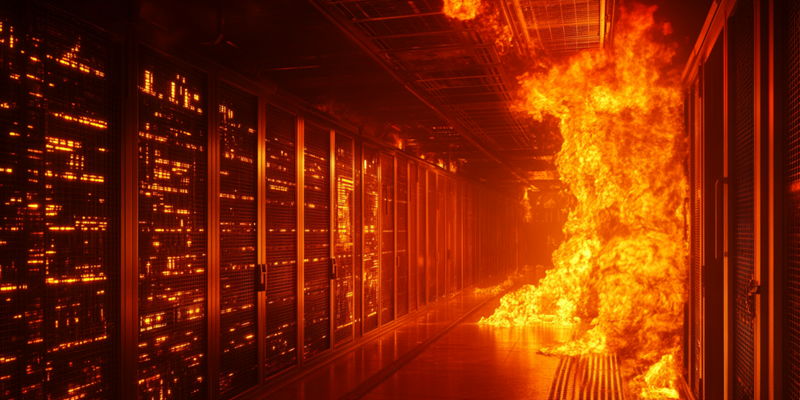On September 10, a fire erupted at the Digital Realty data center in Loyang, Singapore, causing a series of operational disruptions predominantly affecting major tech companies that rely heavily on this facility for their cloud-related services. The blaze originated in one of the battery rooms, leading to significant interruptions for companies such as Lazada, Bytedance, and Alibaba Cloud. Although the structural integrity of the data center remains uncompromised, the extent of the operational fallout has been profound and far-reaching.
Responding to the incident, the SCDF was able to swiftly contain the blaze, which posed an immediate risk to the ongoing operations within the data center. At the time the fire broke out, it specifically impacted two battery rooms, two power supply rooms, and an equipment storage room located on the mezzanine floor of the third story. Preliminary findings pointed toward an electrical cause for the fire, raising alarm about the safety of cloud services infrastructure. Notable disruptions soon followed, emphasizing the interconnected nature of today’s digital economies.
Incident Details and Immediate Impact
The fire broke out within two battery rooms, two power supply rooms, and an equipment storage room situated on the mezzanine floor of the third story, making its cause likely electrical in nature. The SCDF arrived promptly to contain the blaze, leading to immediate shutdowns and evacuations necessary to mitigate risk and ensure safety.
Initial structural assessments conducted by the Building and Construction Authority (BCA) revealed that the building’s structural integrity was not compromised. Despite these favorable findings, levels 3, 3M, and 4 suffered from issues such as plaster delamination, paint peeling, and soot accumulation due to the fire’s heat and smoke. The BCA, as a preventive measure, issued a dangerous building order accompanied by a closure order affecting particular sections of the structure. The goal was to mandate a full structural assessment once debris clearance was achievable, ensuring that potential hidden damages could be adequately addressed before a full operational resumption.
Damping Down Operations and Precautions
Damping down operations continued a day after the blaze to prevent any potential rekindling. A small team remained on-site to monitor heat hotspots, ensuring any residual smoldering did not lead to a resurgence of flames. This methodical protocol aims to minimize further disruptions while safeguarding the data center’s infrastructure for future operations.
Consistent vigilance, coupled with the issuance of closure orders by the relevant authorities, highlights the meticulous approach currently being implemented. The priority remains public safety and facility integrity, with re-entry and services limited until all safety concerns are comprehensively resolved. Such efforts are crucial in preserving not only the building’s structural condition but also the safety of personnel and equipment housed within, underscoring a proactive approach to emergency management that emphasizes thoroughness and caution.
Operational Disruptions for Tech Giants
Notable tech giants reliant on the Digital Realty data center were among the worst affected, with Lazada and Bytedance experiencing significant operational disruptions. The unexpected and extensive downtime had a cascade effect, severely impacting their customers and user experiences, which in turn highlighted the vulnerabilities these companies face when a key infrastructure hub becomes compromised.
Alibaba Cloud, another major entity heavily dependent on the facility, reported severe network connectivity issues exacerbated by high temperatures that affected several cloud products. The exigent firefighting efforts, which included copious amounts of water, led to an accumulation of water and resultant leaks, raising further concerns over potential short circuits that necessitated an emergency power shutdown for one of the server buildings in the Singapore Availability Zone C. This series of events disrupted cloud operations across the zone, making clear the critical interdependencies inherent within large-scale digital service frameworks.
Recovery Efforts and Service Restoration
Engineers from Alibaba Cloud and other affected tech firms have since been working around the clock to restore services to their usual functionality. With the primary aim of reducing operational impact and hastening a return to normalcy, these teams have implemented a range of recovery measures. Although the initial disruptions were severe, concerted and proactive measures have gradually seen network services being restored, reflecting the resilience and preparedness of these tech companies to manage crises.
In response, the collaborative efforts between data center operators, emergency services, and affected tech companies stand out as pivotal for effective crisis management. These integrated actions ensured expeditious mitigation of the disruption, serving as a testament to the robust protocols in place that allow such quick recovery even in the face of significant operational threats. Learning from these experiences will prove crucial to fortifying data center resilience in the future.
Digital Realty’s Role and Responsibilities
On September 10, a fire broke out at the Digital Realty data center in Loyang, Singapore, causing significant disruptions, particularly for major tech companies relying on this facility for their cloud services. According to initial reports from the Singapore Civil Defence Force (SCDF), the fire started in one of the battery rooms, affecting companies such as Lazada, Bytedance, and Alibaba Cloud. While the data center’s structure was not compromised, the widespread operational fallout was substantial.
The SCDF quickly contained the blaze, which threatened the ongoing activities within the data center. The fire specifically damaged two battery rooms, two power supply rooms, and an equipment storage room located on the mezzanine floor of the third story. Initial investigations suggest an electrical malfunction as the cause, raising concerns about the safety of cloud infrastructure. The incident highlighted the interconnected nature of modern digital economies, as notable service disruptions followed, emphasizing the critical reliance on cloud services for daily operations across multiple sectors.

